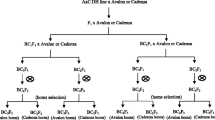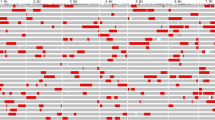Abstract
The expression of a quantitative phenotype can be controlled through genotype, environment and genotype by environment interaction effects. Further, genotype effects can be attributed to major genes, quantitative trait loci (QTL) and gene by gene interactions, which are also termed epistatic interactions. The present study demonstrates that two-way epistatic interactions can play an important role for the expression of domestication-related traits like heading date, plant height and yield. In the BC2DH population S42, carrying wild barley introgressions in the genetic background of the spring barley cultivar Scarlett, 13, 8 and 12 marker by marker interaction effects could be detected for the traits heading date, plant height and yield, respectively. Significant allelic combinations at interacting loci coincided for heading date, plant height and yield suggesting the presence of pleiotropic effects rather than several linked QTL. The mode of epistasis observed was primarily characterised by either (1) compensatory effects, where allelic combinations from the same genotype buffered the phenotype, or (2) augmented effects, where only the combination of the exotic allele at both interacting loci caused an altered phenotype. The present study shows that estimates of main effects of QTL can be confounded by interactions with background loci, suggesting that the identification of epistatic effects is important for gene cloning and marker-assisted selection. Furthermore, interaction effects between loci and putative candidate genes detected in the present study reveal potential functional relationships, which can be used to further elucidate gene networks in barley.


Similar content being viewed by others
References
Alcázar R, García AV, Parker JE, Reymond M (2009) Incremental steps toward incompatibility revealed by Arabidopsis epistatic interactions modulating salicylic acid pathway activation. Proc Natl Acad Sci USA 106:334–339
Allard RW (1988) Future directions in plant population genetics, evolution and breeding. In: Brown ADH, Clegg MT, Kahler AL, Weir BS (eds) Plant population genetics and germplasm resources. Sinauer Associates Inc., Sunderland, pp 1–19
Benjamini J, Yekutieli B (2005) Quantitative trait loci analysis using the false discovery rate. Genetics 171:783–790
Bomblies K, Lempe L, Epple P, Warthmann N, Lanz C, Dangl JL, Weigel D (2007) Autoimmune response as a mechanism for a Dobzhansky-Muller-type incompatibility syndrome in plants. PLoS Biol 5:e236
Cockerham CC, Zeng ZB (1996) Design III with marker loci. Genetics 143:1437–1456
Doebley J, Stec A, Gustus C (1995) Teosinte branched1 and the origin of maize: evidence for epistasis and the evolution of dominance. Genetics 141:333–346
Dubcovsky J, Chen C, Yan L (2005) Molecular characterization of the allelic variation at the VRN-H2 vernalization locus in barley. Mol Breed 15:395–407
Dunnett CW (1955) A multiple comparisons procedure for comparing several treatments with a control. J Am Stat Assoc 50:1096–1121
Eshed Y, Zamir D (1996) Less-than-additive epistatic interactions of quantitative trait loci in tomato. Genetics 143:1807–1817
Fasoulas AC, Allard RW (1962) Nonallelic gene interactions in the inheritance of quantitative characters in barley. Genetics 47:899–907
Faure S, Higgins J, Turner A, Laurie DA (2007) The FLOWERING LOCUS T-like gene family in barley (Hordeum vulgare). Genetics 176:599–609
Fisher RA (1918) The correlation between relatives on the supposition of Mendelian inheritance. Trans R Soc Edinburgh 52:399–433
Griffiths S, Dunford RP, Coupland G, Laurie DA (2003) The evolution of CONSTANS-like gene families in barley, rice, and Arabidopsis. Plant Physiol 131:1855–1867
Holland JB (1998) EPISTACY: a SAS program for detecting two-locus epistatic interactions using genetic marker information. J Hered 89:374–375
Hua J, Xing Y, Wu W, Xu C, Sun X, Yu S, Zhang Q (2003) Single-locus heterotic effects and dominance by dominance interactions can adequately explain the genetic basis of heterosis in an elite rice hybrid. Proc Natl Acad Sci USA 100:2574–2579
Imtiaz M, Ogbonnaya FC, Oman J, van Ginkel M (2008) Characterization of quantitative trait loci controlling genetic variation for preharvest sprouting in synthetic backcross-derived wheat lines. Genetics 178:1725–1736
Jia Q, Zhang J, Westcott S, Zhang XQ, Bellgard M, Lance R, Li C (2009) GA-20 oxidase as a candidate for the semidwarf gene sdw1/denso in barley. Funct Integr Genomics 9:255–262
Kikuchi R, Kawahigashi H, Ando T, Tonooka T, Handa H (2009) Molecular and functional characterization of PEBP genes in barley reveal the diversification of their roles in flowering. Plant Physiol 149:1341–1353
Kroymann J, Mitchell-Olds T (2005) Epistasis and balanced polymorphism influencing complex trait variation. Nature 435:95–98
Kubo T, Yamagata Y, Eguchi M, Yoshimura A (2008) A novel epistatic interaction at two loci causing hybrid male sterility in an inter-subspecific cross of rice (Oryza sativa L.). Genes Genet Syst 83:443–453
Lark KG, Chase K, Adler F, Mansur LM, Orf JH (1995) Interactions between quantitative trait loci in soybean in which trait variation at one locus is conditional upon a specific allele at another. Proc Natl Acad Sci USA 92:4656–4660
Li Z, Pinson SRM, Park WD, Paterson AH, Stansel JW (1997) Epistasis for three grain yield components in rice (Oryza sativa L.). Genetics 145:453–465
Li L, Lu K, Chen Z, Mu T, Hu Z, Li X (2008) Dominance, overdominance and epistasis condition the heterosis in two heterotic rice hybrids. Genetics 180:1725–1742
Lukens LN, Doebley J (1999) Epistatic and environmental interactions for quantitative trait loci involved in maize evolution. Genet Res 74:291–302
Luo LJ, Li ZK, Mei HW, Shu QY, Tabien R, Zhong DB, Ying CS, Stansel JW, Khush GS, Paterson AH (2001) Overdominant epistatic loci are the primary genetic basis of inbreeding depression and heterosis in rice. II. Grain yield components. Genetics 158:1755–1771
Malmberg RL, Mauricio R (2005) QTL-based evidence for the role of epistasis in evolution. Genet Res Camb 86:89–95
Malmberg RL, Held S, Waits A, Mauricio R (2005) Epistasis for fitness-related quantitative traits in Arabidopsis thaliana grown in the field. Genetics 171:2013–2027
Pooni HS, Coombs DJ, Jinks PS (1987) Detection of epistasis and linkage of interacting genes in the presence of reciprocal differences. Heredity 58:257–266
Rowe HC, Hansen BH, Halkier BA, Kliebenstein DJ (2008) Biochemical networks and epistasis shape the Arabidopsis thaliana metabolome. Plant Cell 20:1199–1216
SAS Institute (2006) The SAS Enterprise guide for Windows, release 4.1. SAS Institute, Cary
Schmalenbach I, Körber N, Pillen K (2008) Selecting a set of wild barley introgression lines and verification of QTL effects for resistance to powdery mildew and leaf rust. Theor Appl Genet 117:1093–1106
Schmalenbach I, Léon J, Pillen K (2009) Identification and verification of QTLs for agronomic traits using wild barley introgression lines. Theor Appl Genet 118:483–497
Spickett S, Thoday JM (1966) Regular response to selection. 3. Interactions between located polygenes. Genet Res 7:96–121
Turner A, Beales J, Faure S, Dunford RP, Laurie DA (2005) The pseudo-response regulator Ppd-H1 provides adaptation to photoperiod in barley. Science 310:1031–1034
von Korff M, Wang H, Léon J, Pillen K (2004) Development of candidate introgression lines using an exotic barley accession (H. vulgare ssp. spontaneum) as donor. Theor Appl Genet 109:1736–1745
von Korff M, Wang H, Léon J, Pillen K (2006) AB-QTL analysis in spring barley: II. Detection of favourable exotic alleles for agronomic traits introgressed from wild barley (H. vulgare ssp. spontaneum). Theor Appl Genet 112:1221–1231
Wang G, Schmalenbach I, von Korff M, Léon J, Kilian B, Rode J, Pillen K (2010) Association of barley photoperiod and vernalization genes with QTLs for flowering time and agronomic traits in a BC2DH population and a set of wild barley introgression lines. Theor Appl Genet 120:1559–1574
Weinig C, Dorn LA, Kane NC, German ZM, Hahdorsdottir SS, Ungerer MC, Toyonaga Y, Mackay TFC, Purugganan MD, Shmitt J (2003) Heterogeneous selection at specific loci in natural environments in Arabidopsis thaliana. Genetics 165:321–329
Wentzell AM, Daniel J, Kliebenstein DJ (2008) Genotype, age, tissue, and environment regulate the structural outcome of glucosinolate activation. Plant Physiol 107:115279v1
Xing YZ, Tan YF, Hua JP, Sun XL, Yu CG (2002) Characterization of the main effects, epistatic effects and their environmental interactions of QTLs on the genetic basis of yield traits in rice. Theor Appl Genet 105:248–257
Xu S, Jia Z (2007) Genomewide analysis of epistatic effects for quantitative traits in barley. Genetics 175:1955–1963
Yan L, Loukoianov A, Blechl A, Tranquilli G, Ramakrishna W, SanMiguel P, Bennetzen JL, Echenique V, Dubcovsky J (2004) The wheat VRN2 gene is a flowering repressor down-regulated by vernalization. Science 303:1640–1644
Yi N, Xu S, Allison DB (2003) Bayesian model choice and search strategies for mapping interacting quantitative trait loci. Genetics 165:867–883
Yi N, Yandell BS, Churchill GA, Allison DB, Eisen EJ, Pomp D (2005) Bayesian model selection for genome-wide epistatic quantitative trait loci analysis. Genetics 170:1333–1344
Yu SB, Li JX, Yu CG, Tan YF, Li XH, Zhang Q, Gao YJ, Saghai Maroof MA (1997) Importance of epistasis as the genetic basis of heterosis in an elite rice hybrid. Proc Natl Acad Sci USA 94:9226–9231
Acknowledgments
We thank Dr. Eberhard Laubach (Nordsaat Saatzucht), Dr. Claus Einfeldt (Saatzucht Dr. J. Ackermann), Mr. Josef Breun (Saatzucht Josef Breun) and their teams for conducting the field experiments. The excellent technical assistance of Merle Noschinski, Carsten Golletz, and the team of our experimental station Dikopshof in Wesseling is appreciated. We also like to thank both reviewers for their critical comments which helped us to further improve the value of the manuscript. This work was funded by the German Plant Genome Research Initiative (GABI) of the Federal Ministry of Education and Research (BMBF, project 0312278A).
Author information
Authors and Affiliations
Corresponding author
Additional information
Communicated by P. Hayes.
Rights and permissions
About this article
Cite this article
von Korff, M., Léon, J. & Pillen, K. Detection of epistatic interactions between exotic alleles introgressed from wild barley (H. vulgare ssp. spontaneum). Theor Appl Genet 121, 1455–1464 (2010). https://doi.org/10.1007/s00122-010-1401-y
Received:
Accepted:
Published:
Issue Date:
DOI: https://doi.org/10.1007/s00122-010-1401-y




